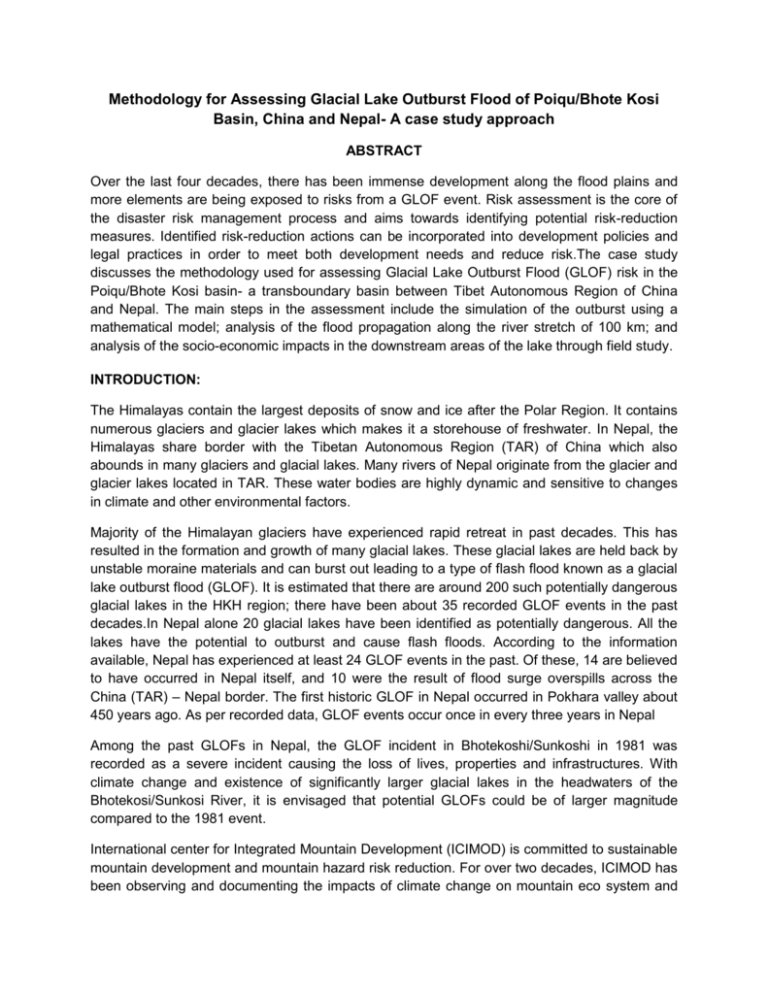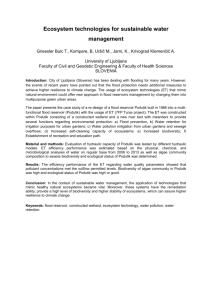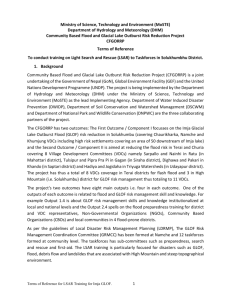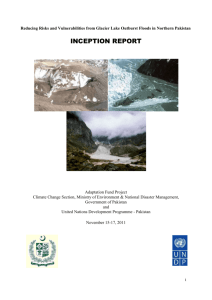Methodology for Assessing Glacial Lake Outburst Flood of Poiqu
advertisement

Methodology for Assessing Glacial Lake Outburst Flood of Poiqu/Bhote Kosi Basin, China and Nepal- A case study approach ABSTRACT Over the last four decades, there has been immense development along the flood plains and more elements are being exposed to risks from a GLOF event. Risk assessment is the core of the disaster risk management process and aims towards identifying potential risk-reduction measures. Identified risk-reduction actions can be incorporated into development policies and legal practices in order to meet both development needs and reduce risk.The case study discusses the methodology used for assessing Glacial Lake Outburst Flood (GLOF) risk in the Poiqu/Bhote Kosi basin- a transboundary basin between Tibet Autonomous Region of China and Nepal. The main steps in the assessment include the simulation of the outburst using a mathematical model; analysis of the flood propagation along the river stretch of 100 km; and analysis of the socio-economic impacts in the downstream areas of the lake through field study. INTRODUCTION: The Himalayas contain the largest deposits of snow and ice after the Polar Region. It contains numerous glaciers and glacier lakes which makes it a storehouse of freshwater. In Nepal, the Himalayas share border with the Tibetan Autonomous Region (TAR) of China which also abounds in many glaciers and glacial lakes. Many rivers of Nepal originate from the glacier and glacier lakes located in TAR. These water bodies are highly dynamic and sensitive to changes in climate and other environmental factors. Majority of the Himalayan glaciers have experienced rapid retreat in past decades. This has resulted in the formation and growth of many glacial lakes. These glacial lakes are held back by unstable moraine materials and can burst out leading to a type of flash flood known as a glacial lake outburst flood (GLOF). It is estimated that there are around 200 such potentially dangerous glacial lakes in the HKH region; there have been about 35 recorded GLOF events in the past decades.In Nepal alone 20 glacial lakes have been identified as potentially dangerous. All the lakes have the potential to outburst and cause flash floods. According to the information available, Nepal has experienced at least 24 GLOF events in the past. Of these, 14 are believed to have occurred in Nepal itself, and 10 were the result of flood surge overspills across the China (TAR) – Nepal border. The first historic GLOF in Nepal occurred in Pokhara valley about 450 years ago. As per recorded data, GLOF events occur once in every three years in Nepal Among the past GLOFs in Nepal, the GLOF incident in Bhotekoshi/Sunkoshi in 1981 was recorded as a severe incident causing the loss of lives, properties and infrastructures. With climate change and existence of significantly larger glacial lakes in the headwaters of the Bhotekosi/Sunkosi River, it is envisaged that potential GLOFs could be of larger magnitude compared to the 1981 event. International center for Integrated Mountain Development (ICIMOD) is committed to sustainable mountain development and mountain hazard risk reduction. For over two decades, ICIMOD has been observing and documenting the impacts of climate change on mountain eco system and mountain communities. In order to create a sustained mechanism for monitoring the changes in glacial lakes, ICIMOD has developed a methodology for glacial risk assessment and piloted it in selected locations in the year 2009. This case study discusses methodology, its application and results in the Bhotekosi/Sunkosi River. STUDY AREA: The case study is located in the Poiqu/bhote Kosi basin, a transboundary basin between Tibet Autonomous Region of China and Nepal. The total basin area is 3,393 km2 with 60% of the area within China and 40% within Nepal. The river is called Poiqu in Tibet and Bhote Kosi or Sun Kosi in Nepal. The only highway linking Nepal and China (called Araniko highway in Nepal) passes through this basin and is aligned along the Poiqu/Bhote Kosi River. The river basin is leaf shaped, with an average length of 107km and a width of 33km. Nine potential dangerous lakes have been identified in this basin, all located within Tibet. According to an inventory of glaciers and glacial lakes done in 2000, there are altogether 151 glaciers covering 231.58 sq.km area with 19.03 km3 ice reserve. Similarly, there are 139 glacial lakes which cover an area of 16.39 sq.km area. 59 of these lakes are moraine dammed and have a higher susceptibility to outburst. Temporal analysis of glacier dynamics in this basin shows that the number, area and ice reserve are declining but the number of glacial lakes and its area are increasing (Mool et al., 2005). It is a clear indication that the risk of glacial lake outburst flood in Bhotekosi/Sunkoshi is likely to increase in the future. Over the last four decades with the construction of the Kathmandu-Kodari Highway, many settlements have moved from the hilltops to the road side. Along with the increasing number of settlements and population, roads, bridges, hydro power stations have also developed. This development implies that along the flood plain more and more elements are being exposed to risks from a GLOF event. The study was conducted in the river corridor over a distance of 100 km downstream from the lake ending at a town called Dolalghat in Nepal (45km is within Tibet and 55 km within Nepal). The socioeconomic aspect of the study was conducted only in the Nepalese part of the basin. PROCESS OF RISK ASSESSMENT: The risk assessment in the HKH region has been limited to hazard assessment based on mainly secondary data. The studies on GLOF simulation concentrated mostly on outburst simulation and routing the flood along the river valley downstream of the lake. A comprehensive GLOF risk assessment should encompass a hazard assessment of the lake as well as a physical and social vulnerability assessment of the downstream impact areas. The methodology for mapping the hazard compromised of: I. II. Selection of data and models Modeling the scenarios of outburst III. IV. V. Modeling of flood propagation along the Poiqu/Bhote Kosi valley Flood mapping Vulnerability Assessment I. Data and model selection: The data necessary for this detail study of glacial lake outburst are Spatial data (Watershed boundary, drainage network, Inline structures of rivers, Digital Elevation Model (DEM of the study area, Infrastructures – road, bridge, cannel, dam, service centers, etc.; lake information (surface area, maximum depth, top/bottom elevation of lake); Moraine information (inside/outside of slope, dam length and width, unit weight of dam material, outer core of the dam, frictional angle, etc.) and finally socio economic data. The data for the dam breach was taken from the SRTM DEM. As the information regarding geotechnical parameters for both lakes was lacking, the parameters were adapted, similar to Tsho Rolpa GLOF case study (Bajracharya et al. 2007). To conduct the study various computer applications have been used (Arcview 3.2A, HEC‐GeoHMS, HEC‐GeoRAS, v3.2.1, NWS BREACH, BOSS DAMBRK, HECRAS v4 Beta, and AutoCAD). II. Modeling the scenarios of outburst For simulating the nature of flood wave in the case of Dam breach, an erosion model developed by National Weather Service (NWS‐BREACH) was used (Fread 1991). It gives outburst hydrograph. The input parameters are geometric and dam material properties. Geometrical parameters were derived from DEM while geotechnical parameters were adopted as in other similar studies due to unavailability of data. For uncertainty of material properties sensitivity analysis was carried out. The NWS- Breach model was used to stimulate the outburst hydrographs. The model is based on coupling the conservation of mass of reservoir inflow, spillway outflow, and breach outflow with the sediment transport capacity of the unsteady uniform flow along an erosion formed breach channel. The growth of breach is dependent on the dam’s material properties such as size distribution, composition, compaction, unit weight and strength. The outflow hydrograph was obtained through a time-stepping iterative solution not subject to numerical stability or convergence difficulties. With combination of various input parameters within ranges, 33 scenarios with NWS‐BREACH were generated. From this sensitivity analysis was carried out to analyze uncertainty of input parameters III. Modeling of flood propagation along the Poiqu/Bhote Kosi valley For the flood routing, after the GLOF hydrograph was derived from the breach model, the nature of flood propagation in the downstream areas was simulated using BOSS-DAMBRK (Polk 2001). BOSS DAMBRK is a one–dimensional hydrodynamic flood routing software which accounts for dam and bridge failures, storage effects, floodplain overbank flow and flood wave attenuation. The Limuchimi lake and downstream river section of Bhotekoshi/Sunkoshi River up to Dolalghat bridge (Nepal) was simulated with DAMBRK for the detailed analysis of a flood wave downstream. A total number of 29 cross sections were selected at different locations along the river course for which DAMBRK generated flood hydrographs. IV. Flood mapping Hec-GeoRAS was used to produce inundation maps based on the hydrographs generated by DAMBRK. Although Hec‐RAS software can be used for unsteady flow routing, it went unstable during simulation. The problem may be due to extremely steep river slopes and lack of actual field data due to which data used in model could not represent actual field at some portion of river section. To overcome this problem BOSS‐DAMBRK was used for unsteady flow routing using the results from NWS‐BREACH and the output hydrographs generated at 6 locations were utilized as input in HEC‐RAS 4 Beta and steady flow simulation was performed so that simulation result could be exported to Hec‐GeoRAS which is capable for producing inundation maps in GIS environment. Map 1 shows the flood inundation scenario in the Poique/Bhote. Map 1: Flood Inundation map- Pioque/Bhote Koshi Basin. Source: Glacier Lake outburst Flood Modeling of lumu Schimi lake Poiqu/ Bhote Kosi Basin V. Vulnerability Assessment The property and infrastructures exposed to the flood hazard zone were quantified and mapped. The final flood map was used to extract the land cover from the land cover map produced by Department of Survey at 1:50,000 and 1:25,000 scale provided by ICIMOD. The vulnerability was estimated by the land cover type which is exposed by GLOF risk. The specific spots were identified and a field visit was done for checking the result at some of vulnerable points. The pre-assessment of the potential damage was estimated by studying the land cover map and the area exposed to GLOF risk. For the Socio-economic risk assessment, the past GLOF of 1981 was taken as a baseline event. There is no systematic information available on this event but newspapers recordings and discussions with elderly people provided useful information of that event. Both secondary and primary sources of information have been used. Published and unpublished reports, newspapers, books, maps etc. were collected and reviewed. A two week long field survey was conducted to collect primary information. Property damages are the most common form of damages in GLOF or flood events. Damages are grouped into several categories, namely, direct, indirect, secondary, intangible and uncertainty damages. Tangible/Direct damages are immediate and can be external or structural in nature. Tangible damages can be estimated in monetary units. Indirect damages are induced damages resulting from the direct damages. An example of indirect damage is closure of business or additional cost due to the flood event. Secondary damages are when different groups of people depend on different services that originate from the area where the damages have occurred. For example, if a hydropower gets affected and the electricity supply is reduced impacting consumers and also affecting the total GDP. Intangible damages reflect negative impacts on social life of individuals and communities along with loss of important heritage sites and environmental qualities. RESULTS The most likely breach scenario suggests the peak discharge will be about 7900 m 3/s. During the peak flood period, the flood level can rise up to 15 m above the river bottom at various locations along the river. Nearly 900 households with the total population of 5800 will be directly affected if the floods with the same magnitude of 1981 GLOF occur. Additional 1653 households with a population of 10531 will be affected if the flood with higher magnitude occurs. Since the Araniko Highway along the Sunkoshi/Bhotekosi River are exposed to the flood damage, the flow of vehicles, goods and people is likely to be affected along with a number of VCDs that lie in that region. In addition, many more people involved in international trade with China and the tourism activities along Tatopani and Khumbu region will be affected. Many people in other districts depend on this highway for supply of manufactured goods and agriculture inputs and export of fruits, vegetables and milk. In case of a GLOF event, two hydropower dams in the region and all the power plants are likely to be affected which will cut down on the supply of electricity to local areas, small towns and Kathmandu city. This will lead to the disruption in livelihoods and economic activities. Other basic needs like drinking water supply and communication cables will be damaged in the likely event of a GLOF, leading to negative health impacts and further affecting the income of the individuals not only from that region but also who are involved in trade and tourism activities. Graph 1 shows the estimated risk in different areas or estimated value of elements at risk Graph 1: Estimated Amount of GLOF Risk Source: An Assessment of Glacial Lake Outburst Flood in the Bhote Kosi Basin (2008) Direct damages will be by far the largest. When real estate and infrastructures are taken together direct damages account for 75% of total damages at the 1981 flood level. When the flood level is assumed to increase by 10 meters the direct damages account for 79% of the total damages. Within the direct damages the hydro power station damage accounts for the biggest chunk of damage (61%). The secondary damages account for 25% of the overall damages which indicates that the impact of the flood will go beyond the flood prone area. The estimated total value of properties exposed to GLOF risk is 11.150 million rupees (USD 159 million) under the condition that the magnitude of likely GLOF is the same as of 1981. If the GLOF with flood level 10m higher than that of 1981 occurs then the estimated property at risk is about 13,846 million rupees (USD 197 million). The share of hydroelectricity projects, international trade and private and public buildings is comparatively high. Hydropower projects share more than 72% (60% infrastructure loss plus 12% revenue loss) of the total amount of the elements exposed followed by international trade (12%) and private and public building (9.13%) at the 1981 flood level. There will be a drastic increase in the share of private properties-buildings, land and crops and roads if the magnitude of the GLOF was increased by 10 percent. Because of the difficulties in estimating monetary value of livelihood support system- household income, health and comfort, are not incorporated into the estimation. So, the actual monetary value of damages will be higher than estimated in the study. The figures on the right present the damages estimation by the sites/blocks. Damages are highest in Hindi because the Bhotekosi hydro power plant is located in this block. Khadichaur is second, and again Sunkosi hydro power project is located in this block. Table 1: Damages Estimation of Flood in Bhote Kosi Valley Sectors Elements Direct Damag es/Real Estate Khet Bari Housing Plot Pakki-house Kachhi-house Total Direct Damag es /Public Infrastr ucture Road Trail Embankment Motorable Bridge Suspension Bridge Water Mills Drinking water schemes Hydropower station Transmission line Fibre cable Total Indirect Paddy 1981 Flood Level 10 m + 1981 Flood Level Rs '000' Share (%) Rs '000' Share (%) 109250 15925 16350 858700 159650 1159875 0.98 0.14 0.15 7.70 1.43 10.40 398450 91975 80285 1867800 525750 2964260 2.89 0.67 0.58 13.55 3.81 21.51 240000 700 4000 60000 22500 1200 1750 2.15 0.01 0.04 0.54 0.20 0.01 0.02 605000 10700 4000 210000 37500 4500 5500 4.39 0.08 0.03 1.52 0.27 0.03 0.04 6755000 122500 8058 7215708 60.58 1.10 0.07 64.71 6755000 336875 20510 7989585 49.01 2.44 0.15 57.97 2801 0.03 11776 0.09 Damag es /Agricul tural Sector Wheat Maize Millet Potato Fruits Vegetables Livestock Total Second aryDam ages Custom Hydropower Total Total 418 1152 248 20 1092 4158 8040 17928 0.00 0.01 0.00 0.00 0.01 0.04 0.07 0.16 2095 5332 1657 761 3266 18828 29000 72716 0.02 0.04 0.01 0.01 0.02 0.14 0.21 0.53 1367000 1389600 2756600 12.26 12.46 24.72 1367000 1389600 2756600 9.92 10.08 20.00 Rs '000' 11150111 100.00 13783161 100.00 US$ (Rs 75= $US 1) 148668 183775 Source: An Assessment of Glacial Lake Outburst Flood in the Bhote Kosi Basin (2008) CONCLUSION: In light of some incidents of past economic losses from GLOF events and the identification of number of potentially dangerous glacial lakes, donors, project financiers and companies require a comprehensive risk assessment for new development projects. Decisions regarding any investment in early warning systems and insurance require a good understanding of an existing GLOF risk. Risk assessment is the core of the disaster risk management process and aims towards identifying potential risk-reduction measures. Risk assessments integrated into the development planning process can identify actions that meet both development needs and reduced risk. Identified risk-reduction actions can be incorporated into development policies and legal practices. The case study shows that technical and social techniques can result in better risk assessment. A systematic risk assessment provides understanding of both hazard (physical) and vulnerability (social and physical) and can form a good basis for mitigation planning. The methodology used in this case study can be replicated with appropriate modification according to the context. The case study also shows that in some cases (when GLOF risks are situated in populated areas) the socio-economic impacts of GLOF risks cannot be ignored. The case study further highlights the transboundary nature of the issue in certain cases and the need for regional collaboration. Sources: ICIMOD (2009) Glacier Lake Outburst Flood Modeling of Lumu Chimi Lake Poiqu/Bhote Kosi Basin, ICIMOD unpublished report; ICIMOD (2009) GLOF Risk Assessment in Bhote Kosi (Sun Kosi) Basin, ICIMOD unpublished report; ICIMOD (2000) Monitoring of Glaciers and Glacial Lakes from 1970s to 2000 in Poiqu Basin, Tibet Autonomous Region, PR China.









